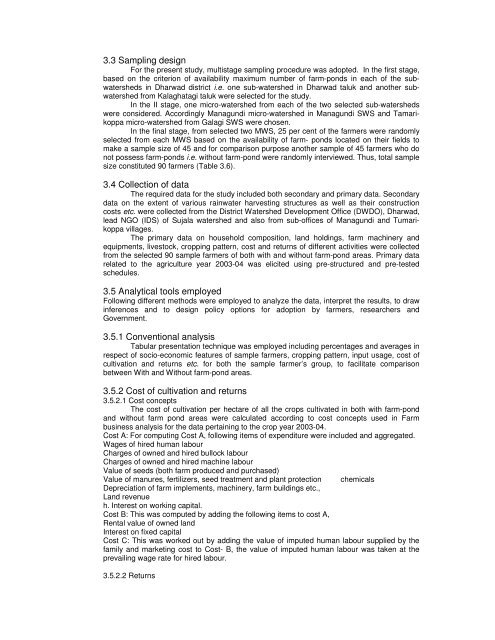Master of Science - ETD | Electronic Theses and Dissertations of ...
Master of Science - ETD | Electronic Theses and Dissertations of ...
Master of Science - ETD | Electronic Theses and Dissertations of ...
You also want an ePaper? Increase the reach of your titles
YUMPU automatically turns print PDFs into web optimized ePapers that Google loves.
3.3 Sampling design<br />
For the present study, multistage sampling procedure was adopted. In the first stage,<br />
based on the criterion <strong>of</strong> availability maximum number <strong>of</strong> farm-ponds in each <strong>of</strong> the subwatersheds<br />
in Dharwad district i.e. one sub-watershed in Dharwad taluk <strong>and</strong> another subwatershed<br />
from Kalaghatagi taluk were selected for the study.<br />
In the II stage, one micro-watershed from each <strong>of</strong> the two selected sub-watersheds<br />
were considered. Accordingly Managundi micro-watershed in Managundi SWS <strong>and</strong> Tamarikoppa<br />
micro-watershed from Galagi SWS were chosen.<br />
In the final stage, from selected two MWS, 25 per cent <strong>of</strong> the farmers were r<strong>and</strong>omly<br />
selected from each MWS based on the availability <strong>of</strong> farm- ponds located on their fields to<br />
make a sample size <strong>of</strong> 45 <strong>and</strong> for comparison purpose another sample <strong>of</strong> 45 farmers who do<br />
not possess farm-ponds i.e. without farm-pond were r<strong>and</strong>omly interviewed. Thus, total sample<br />
size constituted 90 farmers (Table 3.6).<br />
3.4 Collection <strong>of</strong> data<br />
The required data for the study included both secondary <strong>and</strong> primary data. Secondary<br />
data on the extent <strong>of</strong> various rainwater harvesting structures as well as their construction<br />
costs etc. were collected from the District Watershed Development Office (DWDO), Dharwad,<br />
lead NGO (IDS) <strong>of</strong> Sujala watershed <strong>and</strong> also from sub-<strong>of</strong>fices <strong>of</strong> Managundi <strong>and</strong> Tumarikoppa<br />
villages.<br />
The primary data on household composition, l<strong>and</strong> holdings, farm machinery <strong>and</strong><br />
equipments, livestock, cropping pattern, cost <strong>and</strong> returns <strong>of</strong> different activities were collected<br />
from the selected 90 sample farmers <strong>of</strong> both with <strong>and</strong> without farm-pond areas. Primary data<br />
related to the agriculture year 2003-04 was elicited using pre-structured <strong>and</strong> pre-tested<br />
schedules.<br />
3.5 Analytical tools employed<br />
Following different methods were employed to analyze the data, interpret the results, to draw<br />
inferences <strong>and</strong> to design policy options for adoption by farmers, researchers <strong>and</strong><br />
Government.<br />
3.5.1 Conventional analysis<br />
Tabular presentation technique was employed including percentages <strong>and</strong> averages in<br />
respect <strong>of</strong> socio-economic features <strong>of</strong> sample farmers, cropping pattern, input usage, cost <strong>of</strong><br />
cultivation <strong>and</strong> returns etc. for both the sample farmer’s group, to facilitate comparison<br />
between With <strong>and</strong> Without farm-pond areas.<br />
3.5.2 Cost <strong>of</strong> cultivation <strong>and</strong> returns<br />
3.5.2.1 Cost concepts<br />
The cost <strong>of</strong> cultivation per hectare <strong>of</strong> all the crops cultivated in both with farm-pond<br />
<strong>and</strong> without farm pond areas were calculated according to cost concepts used in Farm<br />
business analysis for the data pertaining to the crop year 2003-04.<br />
Cost A: For computing Cost A, following items <strong>of</strong> expenditure were included <strong>and</strong> aggregated.<br />
Wages <strong>of</strong> hired human labour<br />
Charges <strong>of</strong> owned <strong>and</strong> hired bullock labour<br />
Charges <strong>of</strong> owned <strong>and</strong> hired machine labour<br />
Value <strong>of</strong> seeds (both farm produced <strong>and</strong> purchased)<br />
Value <strong>of</strong> manures, fertilizers, seed treatment <strong>and</strong> plant protection chemicals<br />
Depreciation <strong>of</strong> farm implements, machinery, farm buildings etc.,<br />
L<strong>and</strong> revenue<br />
h. Interest on working capital.<br />
Cost B: This was computed by adding the following items to cost A,<br />
Rental value <strong>of</strong> owned l<strong>and</strong><br />
Interest on fixed capital<br />
Cost C: This was worked out by adding the value <strong>of</strong> imputed human labour supplied by the<br />
family <strong>and</strong> marketing cost to Cost- B, the value <strong>of</strong> imputed human labour was taken at the<br />
prevailing wage rate for hired labour.<br />
3.5.2.2 Returns
















